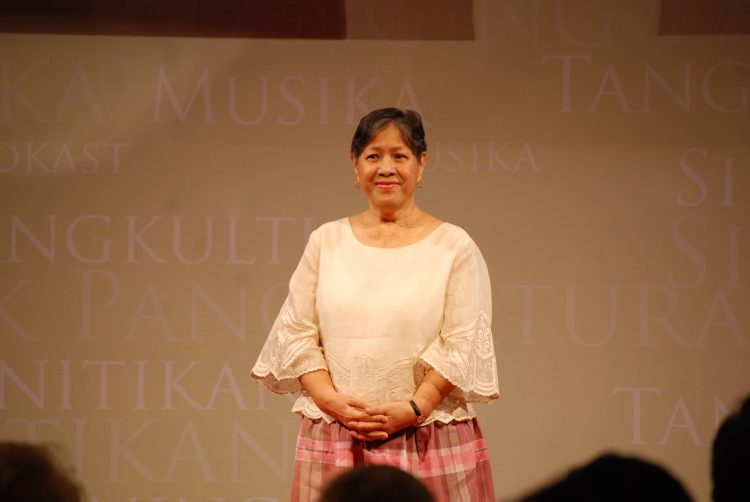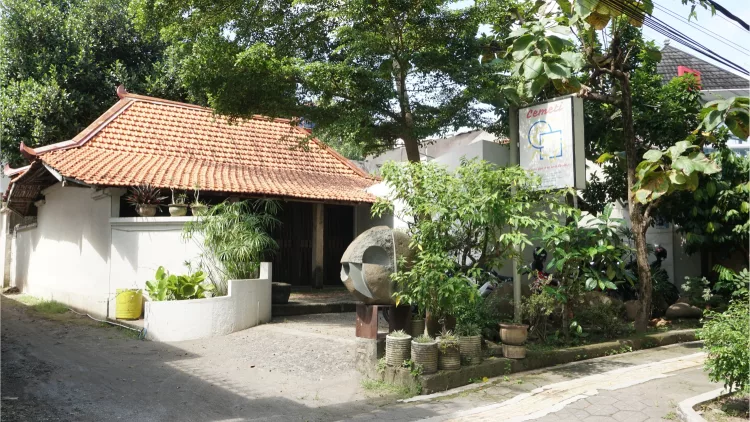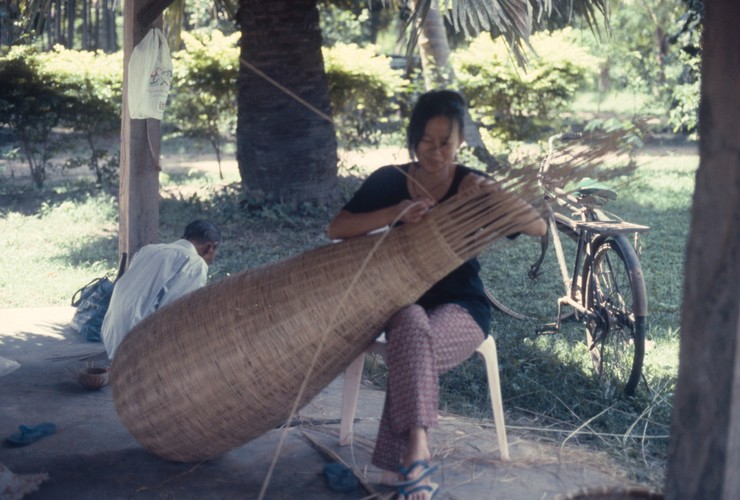Research
Brenda Fajardo, Self-Portrait, 2006–2011, colored ink on paper © Courtesy of Tin-aw Art Management and Brenda V. Fajardo estate
Filipina printmaker and painter Brenda Fajardo (1940–2024) is known for her cultural advocacies and scholarship. She graduated from the University of the Philippines (UP) Los Baños in 1959 with a degree in Agriculture. She then proceeded to study for her master’s degree in Art Education at the University of Wisconsin, Madison, United States on a Fulbright-Hays Grant in 1967. There, B. Fajardo also started her path as an educator at the Wisconsin public schools of Madison and Stevens Point. In 1968, upon returning to her home country, she had her first group show with the Art Association of the Philippines. In 1974, during the start of the Marcos dictatorship, her first solo show was held. Her body of work intersects the personal with sociopolitical and sociohistorical contexts. Infusing the imagined with the figurative in her signature folk style, she is known for her recurrent use of tarot cards, which began in the late 1980s. Originally from medieval Europe, tarot cards were initially used for games before they were eventually employed in the art of divination. Attuning it to the Philippine context, she would render the archetypes into their Filipino counterparts. B. Fajardo did this through a playful transformation of the setting and costumes, as well as adding characters into the picture to reintroduce history within a thematic tableau.
There are repeated visual elements in the way she presents the tarot. The Babaylan [The Priestess], for instance, is clothed in a baro’t saya [traditional women’s costume] with a bowl on her head as she sits in between two coconut trees, holding what looks to be a piece of paper close to her chest. Fajardo also created the opposite binary, the Gaga [The Fool] which is a woman holding a pole with her personal belongings, running towards the sun near the horizon while a dog bites at her heel. According to the artist, this is her “personal symbol…It is a comment on the fact that women can aspire towards and to some extent control their destiny instead of just accepting the circumstances that pull them down.”1 There is also Ang Araw [The Sun], where a newsboy stands on one side and a young girl, a sampaguita vendor, on the other, against a vertical Philippines flag. Ang Buwan [The Moon] has two dogs barking with a lobster between them under a half-sun/half-moon in the sky and two houses in the background. Demonyo [The Devil] stands on a cylindrical object with chains held by two naked women, and in Kamatayan [Death], a skeleton is burying people in fertile ground, with a head and hand protruding from the earth. Paghuhukom [Judgement] shows three women reaching out to an angel-like figure with a trumpet in the sky. Ang Bituin [The Star] depicts a naked woman sitting next to a river, pouring water in and out of it, beneath three prominent stars with a landscape in the background. Katarungan [Justice] is shown in two ways: as a woman sitting on a chair holding a sword, with or without a blindfold on.
The tarot cards often are at the centre of the image or are shown as standalone pieces. However, there are other works where the tarot cards are bordering the sides of another painting. This is true in her Cards of Life – Women’s Series (1993), pen and ink depictions of women from different facets, phases and ages of life, from colonial to present-day Philippines. These include Mga Bababe sa Panahon ng Espanyol [Women during the Spanish colonial period], Mga Babae sa Pagdating ng Amerikano [Women at the coming of the Americans], and Mga Pilipina at mga Hapon [Filipino women and the Japanese]. Here, in each of the drawings we see the women of different ages gathering together, wearing their period-specific clothing, enclosed by various tarot cards. On the panels, over and under the main images, are scribbles by B. Fajardo telling stories about the women in the images. Behind the women in the American and Japanese periods are soldiers, as though keeping the women in check. This series also includes Ako ay Babae, Ako ay Pilipina [I am a woman, I am Filipina], where women of different ages and ethnic groups stand against a brown background with several of the tarot cards on its perimeter and a leaf-like motif as a border. For the present time, there is Babae at Bayan [Women and Country], where the central image is the divide between women who resemble known politicians, Imelda Marcos and Cory Aquino, and rallying women, with tarot cards on the sides and writings above and below the image. Imelda Marcos is a convicted criminal, the wife of dictator Ferdinand Marcos and mother of current president, Bongbong Marcos Jr., while Cory Aquino was the 11th President of the Philippines, known for her role during the 1986 People Power Revolution when the dictator was put out of power. Another image is Pakikibaka Araw-araw [Daily Struggle], which shows the labour of women, from selling vegetables and sampaguitas to caring for a child. First exhibited at the First Asia Pacific Triennal of Contemporary Art in Queensland Gallery, Brisbane, her main theme for the series was to present women throughout history, taking them out of the marginalised spaces to which they are usually restricted.
Another significant aspect of her tarot paintings, drawings and prints is the longhand texts. As a storyteller, B. Fajardo creates chronicles alongside the images to explain the tableaux portrayed. In the work Pakikibaka Araw Araw [Daily Struggle], she writes: “Araw-araw ay nakikibaka sa maalat, mapait, at mapaklang buhay ang mga kababaihan sa Pilipinas. Sa bahay, pag-alaga sa asawa, magulang, pagluluto, paglalaba, pamamalantsa, pagtanim, pagtinda, pagiging biyahera, pagtrabaho sa pabrika. Nangingibang bayan para maging domestic help, mananahi o entertainer” [Everyday, the women of the Philippines struggle with the salty, bitter and bland in life. In the house, we take care of our spouses, parents, cooking, doing the laundry, ironing, growing food, selling, being a traveller, working in a factory. Going abroad to be domestic helpers, garment workers or entertainers].
Also in 1993, B. Fajardo created Walang Katapusang Pakikibaka [Never Ending Struggle] and Buhay Alamang, Paglukso, Patay! [It’s a shrimp’s life. When it jumps it’s dead!] – both showing the struggles of the masses living in the modern day Philippines. Around the margins of these works are once again various tarot cards, such as Emperador [the Emperor], Kapalaran [Destiny], Ang Tore [the Tower] and Reyna [Queen], amongst others. In the same year, she made her Tarot Cards Series: Filipina Migrant Workers. Done in coloured ink on handmade paper, the focus becomes that of the plight of the Filipina migrant worker, the camaraderie she forms with fellow Filipinos abroad, and the emotional and physical toll this has on her. This displacement and alienation are further highlighted by the row of tarot cards on top of each central image, with scripts underneath it to narrate their stories. In other paintings from the series, one sees the different countries, and the jobs that the women must undertake in these endeavours, “such as Japan, where they work as nightclub entertainers; in Hong Kong, where they are domestic workers and nannies; and in Taiwan, where they work in toy factories while their children are faraway.”2 In 1988, Former President Cory Aquino coined the phrase bagong bayani [modern-day heroes] for overseas foreign workers as “they not only boost the economy through their remittances but are also figures of resilience.”3 This remains a reality today, with the majority of these women working as nurses and caregivers.
The recurring use of tarot cards has been a signature in B. Fajardo’s works. Inspired by Filipino history and myths, she reimagines and merges with them modern-day issues – particularly that of the identity of women. She eventually created variations of the tarot series with Baraha ng Buhay Pilipino [Playing Cards of Filipino Life] in 2005 and Baraha Sang Pangabuhi [Cards of Life] in 2015, continuing this articulation of her interests.
B. Fajardo saw herself as an “art educator”4 and worked at local institutions such as Ateneo de Manila University, the College of the Holy Spirit and UP Department of Humanities (Department of Art Studies by 1989), where she was chairperson from 1985 to 1991. She then pursued a doctorate in Philippine Studies at UP Diliman in 1997, where she was awarded the title of Professor Emeritus on her retirement in 2005. She also worked as a set and costume designer, actor and director for productions by the Philippine Educational Theater Association (PETA). She co-founded the Philippine Art Educators Association, Kababaihan sa Sining at Bagong Sibol ng Kamalayan (KASIBULAN), Baglan Art and Culture Initiatives for Community Development and Dalubhasaan sa Sining at Kultura (DESK). From 1995 to 2001, she was the curator of the UP Jorge B. Vargas Museum. She was also involved in outreach projects for the Cultural Center of the Philippines (CCP), the National Commission for Culture and the Arts (NCCA) and the National Research Council of the Philippines, with specific focus on advocating for artists in the regions. Her extensive practice as an artist, scholar and cultural worker remains relevant in revealing the ills of contemporary society and how we can be emancipated from them. Acting as a spirit guide to the allegorical figures, she poses the tarot cards as directions, guiding the men and women in the images she created in what it means to be Filipino.
Kintanar, Thelma B. and Mendez Ventura, Sylvia, “Brenda Fajardo: Romancing the Tarot,” Self Portraits: Twelve Filipina Artists Speak, Quezon City, Ateneo de Manila University Press, 1999, pp. 87–101.
2
Guillermo, Alice, “Brenda Fajardo: The Babaylan through History,” In Who Owns Women’s Bodies?, edited by Rosario Cruz-Lucero and Rochit Tañedo, Quezon City, Creative Collective Center, 2001, pp. 70–73.
3
Jamie Eugenio, Laurinne. “Overseas Filipino Workers: The Modern-Day Heroes of the Philippines.” Harvard International Review. 11 August 2023: https://hir.harvard.edu/overseas-filipino-workers-the-modern-day-heroes-of-the-philippines/.
4
Kintanar, Thelma B. and Mendez Ventura, Sylvia, “Brenda Fajardo: Romancing the Tarot,” Self Portraits: Twelve Filipina Artists Speak, Quezon City, Ateneo de Manila University Press, 1999, pp. 87–101.
Iris Ferrer is an independent cultural practitioner from Manila, Philippines.
Iris Ferrer, "Brenda Fajardo’s Tarot: Reading the Philippines’ Past, Present and Future." In Archives of Women Artists, Research and Exhibitions magazine, . URL : https://awarewomenartists.com/en/magazine/le-tarot-de-brenda-fajardo-lire-le-passe-le-present-et-lavenir-des-philippines/. Accessed 26 December 2025













